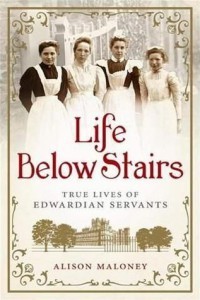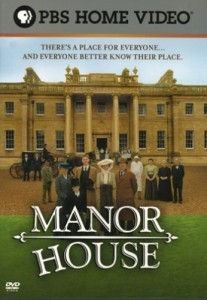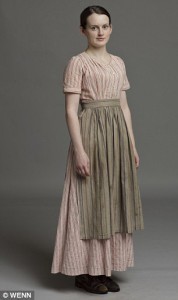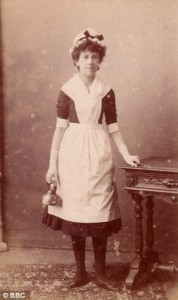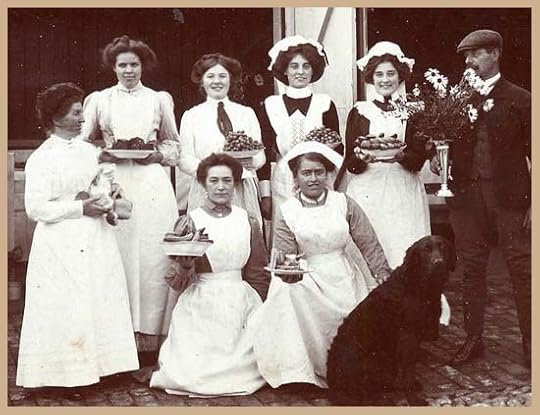Edwardian Servants~Part One
We’ve grown to love the servants on Downton Abbey – Mr. Carson, Mrs. Hughes, Mrs. Patmore, Anna, Daisy, Mr. Bates, Mr. Mosely, and even Thomas and Jimmy. They all seem to be enjoying meals together and forging friendships below stairs, and then they are occasionally called upstairs to set the table or snuff out a candle or two. But what was life really like for servants in Edwardian England? As I researched The Governess of Highland Hall and The Daughter of Highland Hall, that was a question I needed to answer.
I learned a great deal by reading Life Below Stairs by Alison Maloney and watching Manor House, a PBS which is a cultural-reality series that took contemporary people and had them live as the staff and family in a manor house would in the early 1900’s.
The truth about how most servants lived in Britain at the beginning of the twentieth century is quite different than what we see portrayed on Downton Abbey or Upstairs, Downstairs. Clipping your master’s toenails, ironing his shoelaces, spending 17-hour days doing back-breaking work with no employment rights were just some of the realities facing servants in Edwardian Britain.
One and a half million British people worked as servants at the beginning of the Edwardian era, that means one in four people was employed as a domestic servant, and most were women. Upon entering service, servants were often given new names that were generic and easy to remember. Henry, John, and William were popular choices for men, while many female servants were frequently named Mary, Sarah or Emma.
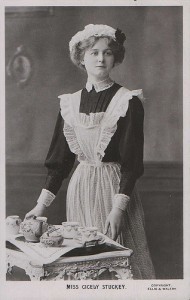 Servants often worked seven days a week, from as early as 5 am until as late as 10 or 11 pm, for very low wages. They were occasionally given a half-day off once a week, but sometime employers didn’t allow even that. Most servants did not work in big stately homes full of fellow workers and camaraderie, but in a middle class town house as the only servant. Instead of enjoying a lively dinner after serving the family upstairs, these servants would live and eat alone in Britain’s dark and damp basement kitchens. Servants in grand houses fared a little better, but they were often hidden from the family by a complex maze of servant stairs and hidden passages throughout the home.
Servants often worked seven days a week, from as early as 5 am until as late as 10 or 11 pm, for very low wages. They were occasionally given a half-day off once a week, but sometime employers didn’t allow even that. Most servants did not work in big stately homes full of fellow workers and camaraderie, but in a middle class town house as the only servant. Instead of enjoying a lively dinner after serving the family upstairs, these servants would live and eat alone in Britain’s dark and damp basement kitchens. Servants in grand houses fared a little better, but they were often hidden from the family by a complex maze of servant stairs and hidden passages throughout the home.
There was a strict hierarchy among members of the staff, and everyone was expected to know their place and show proper respect. The butler and housekeeper ruled over the other servants.
The Servants Roles and Responsibilities
The butler – in charge of the house, coachmen, footmen and wine cellar.
The housekeeper – responsible for the housemaids and carried keys to the china and linen cupboards.
The ladies maid – the mistress of the house’s personal attendant, helping her dress and do her hair.
The valet – the master’s manservant, attending to his requests and preparing his clothes and shaving tools.
The cook – ran the kitchen and larder, overseeing the kitchen, dairy and scullery maids.
The governess - educated and oversaw for the children.
The nursery maid – cared for the children, helped them dress, assisted the governess.
The hall boy – worked 16-hour days, lighting all the lamps and candles and polishing the staff boots.
The tweeny – in-between stairs maid earned £13 a year, worked seven days a week from 5am-10pm.
Come back September 19th for part two and a Special Giveaway of an audio copy of The Governess of Highland Hall!
Would you like to know more about Edwardian Servants? Check out these links: Edwardian Promenade’s article about Edwardian Servants, Jane Austen’s World Article, The Daily Mail Article, Information about the Manor House Series.
Until next time, Happy Reading,
Carrie


